Top contact center automation tools transforming customer service

SEO Outreach Specialist

Tags
Share
Contact centers are evolving from cost centers to strategic assets that drive customer loyalty and business growth. At the heart of this transformation is automation—a set of technologies that are redefining how businesses interact with their customers.
Recent studies illustrate the profound impact of automation in this space. Gartner research reveals that call centers deploying automation technologies achieve 35% greater operational efficiency while reducing average handling times by 25%. Moreover, McKinsey’s and Company also reported that companies leveraging advanced automation tools experienced a 15-20% improvement in customer satisfaction scores.
While the benefits of contact center automation extend beyond mere cost reduction, automating routine inquiries and tasks frees up human agents to handle more complex interactions that require empathy and critical thinking. This not only improves agent job satisfaction but also enhances the overall customer experience.
Let's explore the leading automation tools that are driving this transformation.
Cloud-based contact center solutions
Overview of cloud-infrastructure benefits
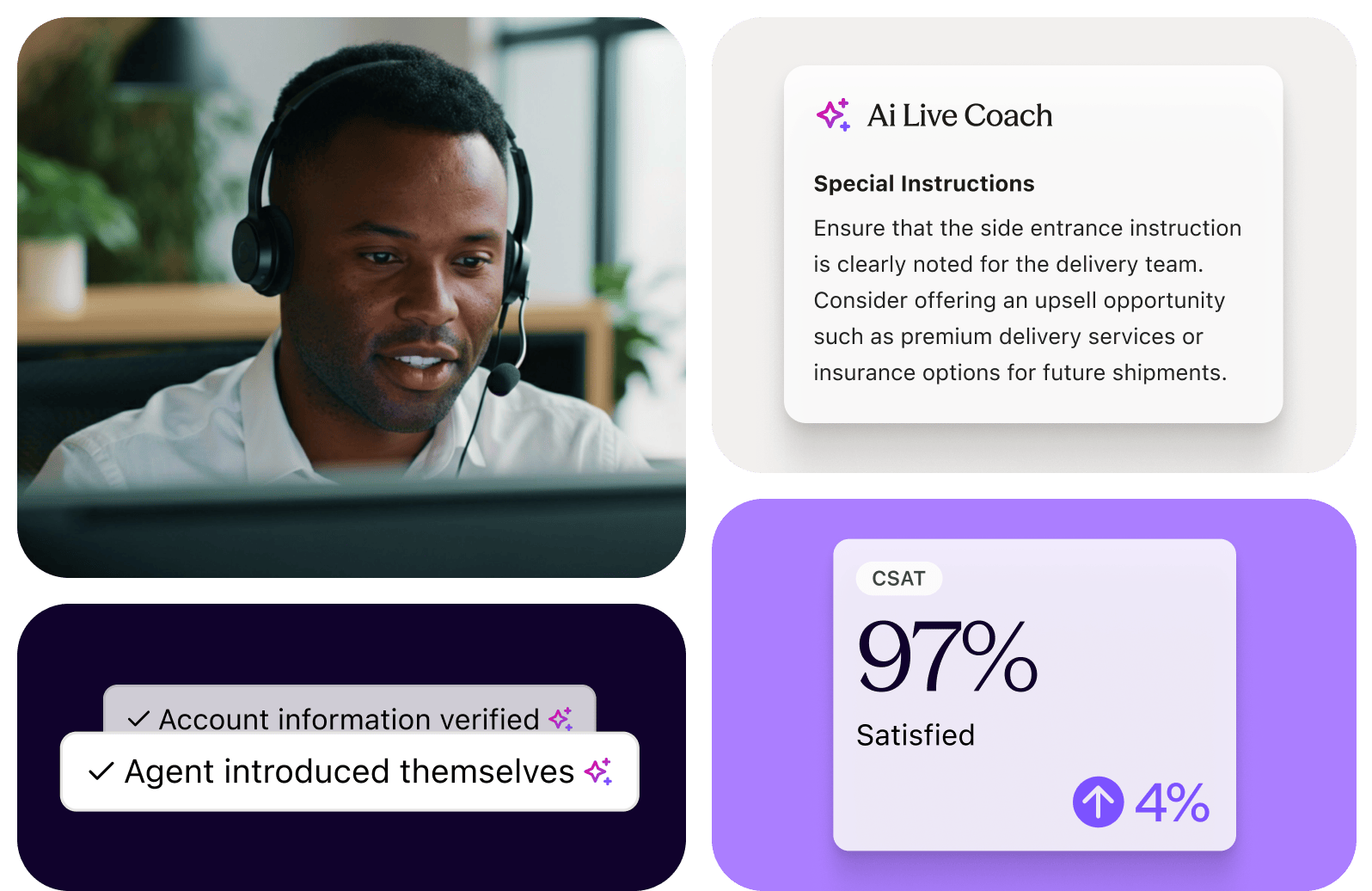
Modern contact centers are increasingly moving away from legacy on-premise systems to cloud-based infrastructure. This shift brings remarkable flexibility, allowing contact centers to scale operations up or down based on demand without significant capital investments.
Cloud solutions also enable remote work capabilities—a feature that proved invaluable during the COVID-19 pandemic and continues to support the hybrid workforce model many companies now embrace.
Cloud infrastructure delivers benefits beyond operational flexibility. These platforms typically offer 99.99% uptime, automatic updates, and built-in redundancy that traditional systems struggle to match.
For contact centers handling sensitive customer data, cloud providers offer enterprise-grade security features and compliance certifications that many in-house IT departments find challenging to implement independently.
Key players in the cloud contact center space
Several vendors have established themselves as leaders in the cloud contact center market:
Dialpad Support delivers a comprehensive cloud contact center communications platform with AI capabilities seamlessly integrated throughout the customer service experience. The solution leverages artificial intelligence for real-time transcription, conversation intelligence, virtual agent automation, sentiment analysis, and omnichannel routing.
Genesys Cloud CX offers an all-in-one solution with extensive AI capabilities and an intuitive interface that makes complex routing and automation accessible to non-technical users. Their platform excels in omnichannel orchestration and workforce optimization.

READ MORE
See how Dialpad Support vs Genesys Cloud CX compare
NICE CXone provides robust analytics alongside cloud flexibility, with particular strengths in quality management and workforce scheduling. Their open platform approach allows for seamless integration with third-party applications.
ANALYZE THE OPTIONS
Get a comprehensive review of Dialpad Support versus NICE CXone.
Five9 Intelligent Cloud Contact Center specializes in practical AI implementation, with strong speech recognition capabilities and flexible deployment options that appeal to mid-market organizations.
STAYING AHEAD
Compare the AI capabilities of Dialpad Support and Five9 Intelligent Cloud Contact Center.
Talkdesk CX Cloud differentiates itself with a focus on rapid innovation cycles and strong digital channel capabilities, making it particularly suitable for companies with evolving customer engagement strategies.
FURTHER READING
Read more about the Top Cloud Contact Center Comparison Guide in 2025
Integration capabilities with existing systems
Modern contact center platforms serve as the central nervous system of customer service operations, requiring seamless integration with customer communications and other business systems. Leading platforms now offer pre-built connectors for popular CRM systems like Salesforce, Microsoft Dynamics, and ServiceNow, enabling agents to access comprehensive customer information without switching between applications.
When discussing the impact of AI on customer communications, Cache Merrill, Founder of Zibtek, offers valuable insights:
"From enabling faster responses to deeply personalized interactions, AI has transformed customer communications."
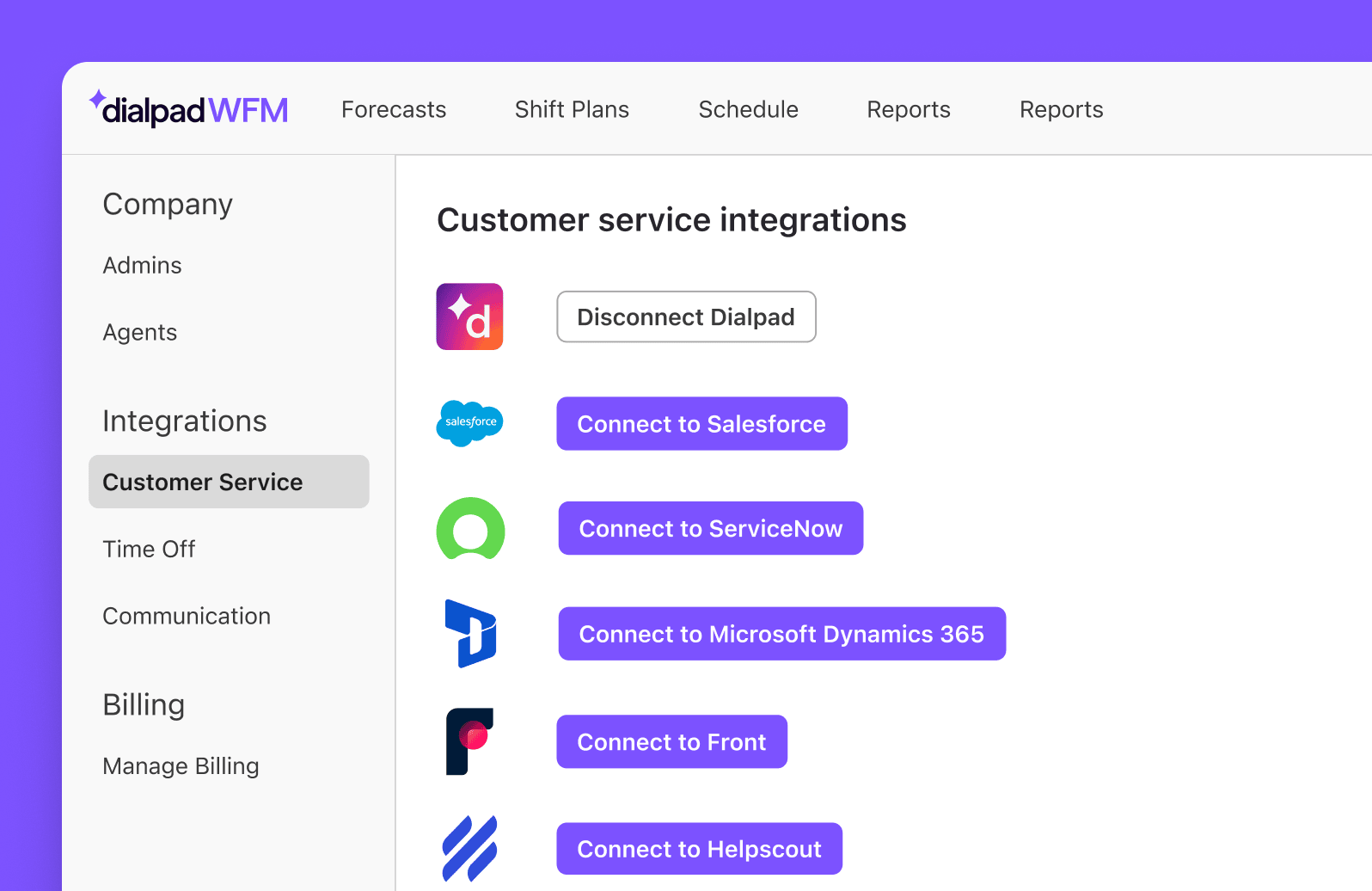
Zibtek has embraced this transformation by utilizing AI-driven tools to automatically manage frequent customer questions, analyze feelings and sentiments, and engage customers through intelligent chatbots and predictive analytics. This approach allows them to "anticipate client needs, support them immediately, and customize responses at an unprecedented scale - while never losing the human aspect."
Merrill highlights three key factors that drove their shift to AI-powered solutions: efficiency, scalability, and customer experience. As a technology company working with both startups and enterprises, they needed a way to handle a high volume of interactions without sacrificing quality. AI has allowed them to "enhance the quality of support, reduce response times, and allocate our team's time towards more complex tasks that carry greater value."
The careful balance of personalization and scalability is achieved through a blend of AI and human interaction. While humans handle sensitive conversations, AI takes on the "heavy lifting of day-to-day questions and routine data-driven insights." Furthermore, data encryption and compliance features provided by their AI tools ensure customer information remains safe, creating a communication strategy that is both "highly efficient while remaining deeply personalized."
Beyond CRM integration, these platforms connect with knowledge management systems, ticketing solutions, and enterprise resource planning (ERP) software through standardized APIs. The most sophisticated solutions offer low-code or no-code integration tools that empower business users to create custom workflows without extensive IT support.
AI-powered chatbots and virtual assistants
How conversational AI is transforming first-line support
Conversational AI has evolved dramatically from the rule-based chatbots of the past. Today's AI-powered virtual assistants can understand context, remember previous interactions, and handle complex customer inquiries with remarkable accuracy.
Leading solutions like Dialpad customer service chatbots, IBM Watson Assistant, Google Dialogflow, and Microsoft Bot Framework provide the foundation for sophisticated virtual assistants that can be customized for specific industry needs.
For example, banking chatbots can securely handle account inquiries and transactions, while healthcare virtual assistants can manage appointment scheduling and preliminary symptom assessment.
Adam Czeczuk, Head of Consulting Services at Think Beyond, offers a crucial perspective on balancing AI efficiency with genuine customer engagement:
"We use AI to speed up customer chats while keeping them natural and warm-no robot speak allowed. AI tackles the routine stuff, handling basic questions so our team can dive into meatier conversations. We're not ditching human touch-we're making sure when customers connect with us, the conversation counts."

Czeczuk elaborates on the necessity of AI for growth without compromising quality. Their approach to integrating AI chat and email systems focuses on sorting messages by urgency and routing complex inquiries to human teams, thereby "zapping quick answers to simple questions while routing tricky ones straight to our team." This strategy effectively prevents customers from "getting stuck in those maddening automated loops."
He concludes with a powerful reminder about AI's role:
"I've watched companies go overboard with automation, thinking AI could replace genuine connections. It can't. AI should enhance real relationships, not pretend to be one. The winners? They'll be the ones who nail this sweet spot and keep customers coming back for more."
Self-service capabilities and their impact on resolution times
Modern chatbots excel at empowering customers to solve their own problems. These self-service capabilities handle everything from password resets and order tracking to product recommendations and technical troubleshooting. By providing immediate responses to common inquiries, chatbots significantly reduce resolution times—sometimes from days or hours to mere seconds.
The impact on customer satisfaction can be substantial. According to a recent study by Juniper Research, chatbots will save businesses over 2.5 billion customer service hours by 2024, translating to $11 billion in cost savings. More importantly, when implemented thoughtfully, these tools address the growing customer preference for self-service options, with Zendesk's Customer Experience Trends Report (2024) reporting that 67% of customers prefer self-service over speaking with a company representative.
Natural Language Processing Advancements
Recent advancements in natural language processing (NLP) are removing the frustration traditionally associated with automated interactions. Stanford’s AI index reported that NLP systems have improved and now can achieve near human conversation. Modern NLP engines can detect sentiment, understand multiple intents within a single message, and even recognize when to transfer a conversation to a human agent.
Technologies like GPT(Generative Pre-trained Transformer) and BERT (Bidirectional Encoder Representations) have dramatically improved how machines understand human language, enabling more natural conversations.
These advancements allow chatbots to handle nuanced requests and provide contextually relevant responses that feel less robotic and more helpful. Vendors like Dialpad, LivePerson, Intercom, and Ada are incorporating these technologies to create virtual assistants that continuously improve through machine learning.
Intelligent call routing systems
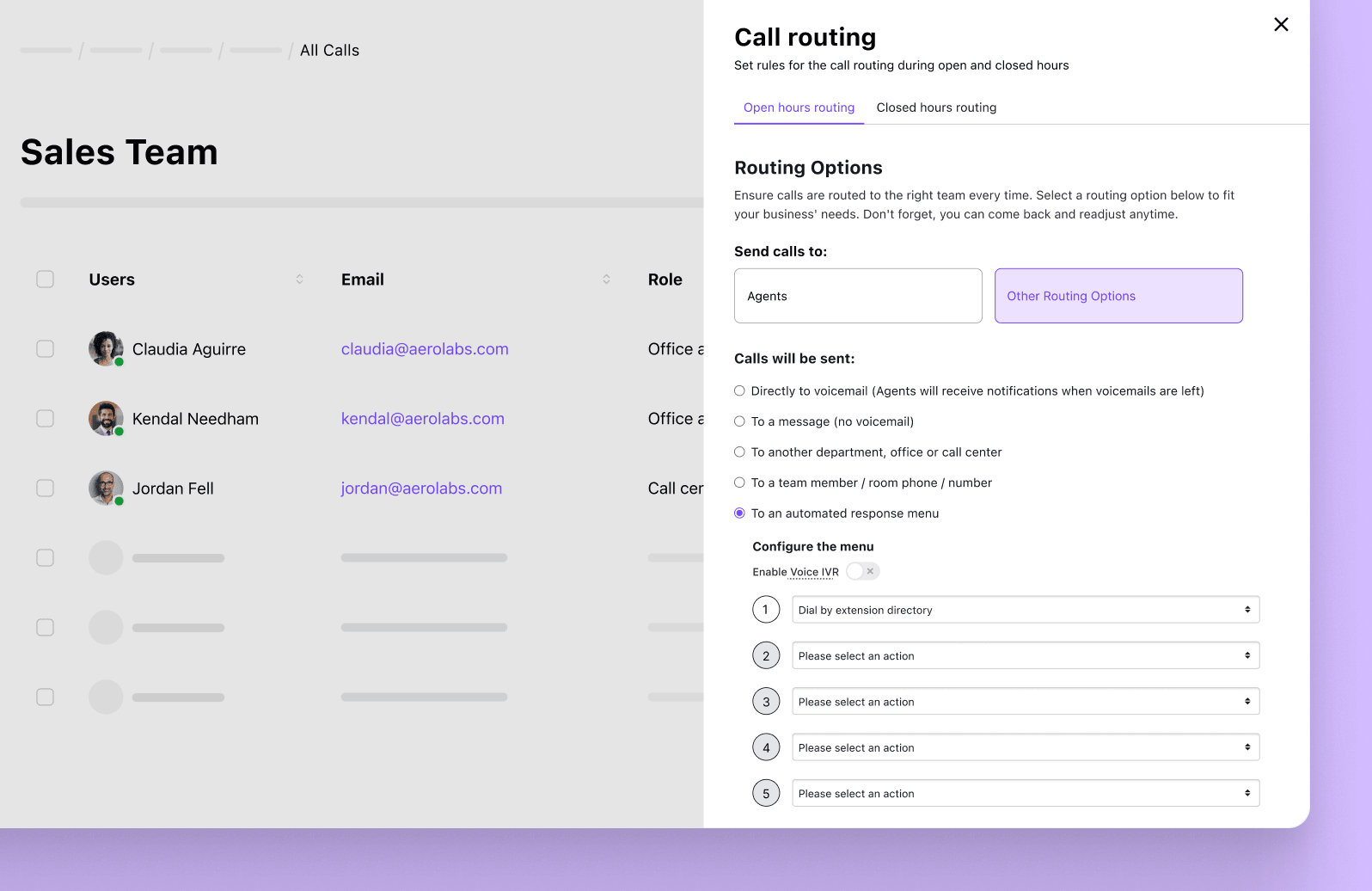
Skills-based routing technology
Traditional call center routing relied primarily on simple queue-based systems or basic IVR menu options. Modern intelligent routing systems use skills-based algorithms to match customers with the most appropriate agent based on factors like technical expertise, language proficiency, or product specialization.
Skills-based routing ensures that customers connect with agents equipped to solve their specific issues, reducing transfers and improving first-contact resolution rates. Advanced systems maintain dynamic skill profiles for each agent, automatically updating based on training completion, performance metrics, and successful resolution of particular issue types.
Predictive routing based on customer history and AI
Predictive routing takes intelligent distribution to the next level by leveraging AI to analyze historical interaction data and predict which agent will provide the best experience for each specific customer. These systems consider factors such as the customer's communication style, past purchasing behavior, and satisfaction scores from previous interactions.
Companies like Talkdesk, NICE, and Genesys offer predictive routing capabilities that improve resolution rates by up to 20% while simultaneously increasing both customer and agent satisfaction, according to Forrester Wave for CCaaS report. These systems foster more productive conversations by pairing customers with agents who have compatible communication styles or proven success with similar issues.
Omnichannel routing capabilities
Today's customers expect seamless service regardless of the communication channel they choose. Like Dialpad Support, omnichannel routing systems unify queues across voice, email, chat, social media, and messaging platforms, allowing businesses to prioritize and distribute work based on business value rather than channel-specific silos.
Advanced systems can intelligently route interactions across channels based on agent availability, workload, and proficiency. For example, an agent might handle a voice call while simultaneously responding to asynchronous text-based inquiries during natural pauses in the conversation, maximizing productivity without compromising service quality.
Interactive voice response (IVR) systems
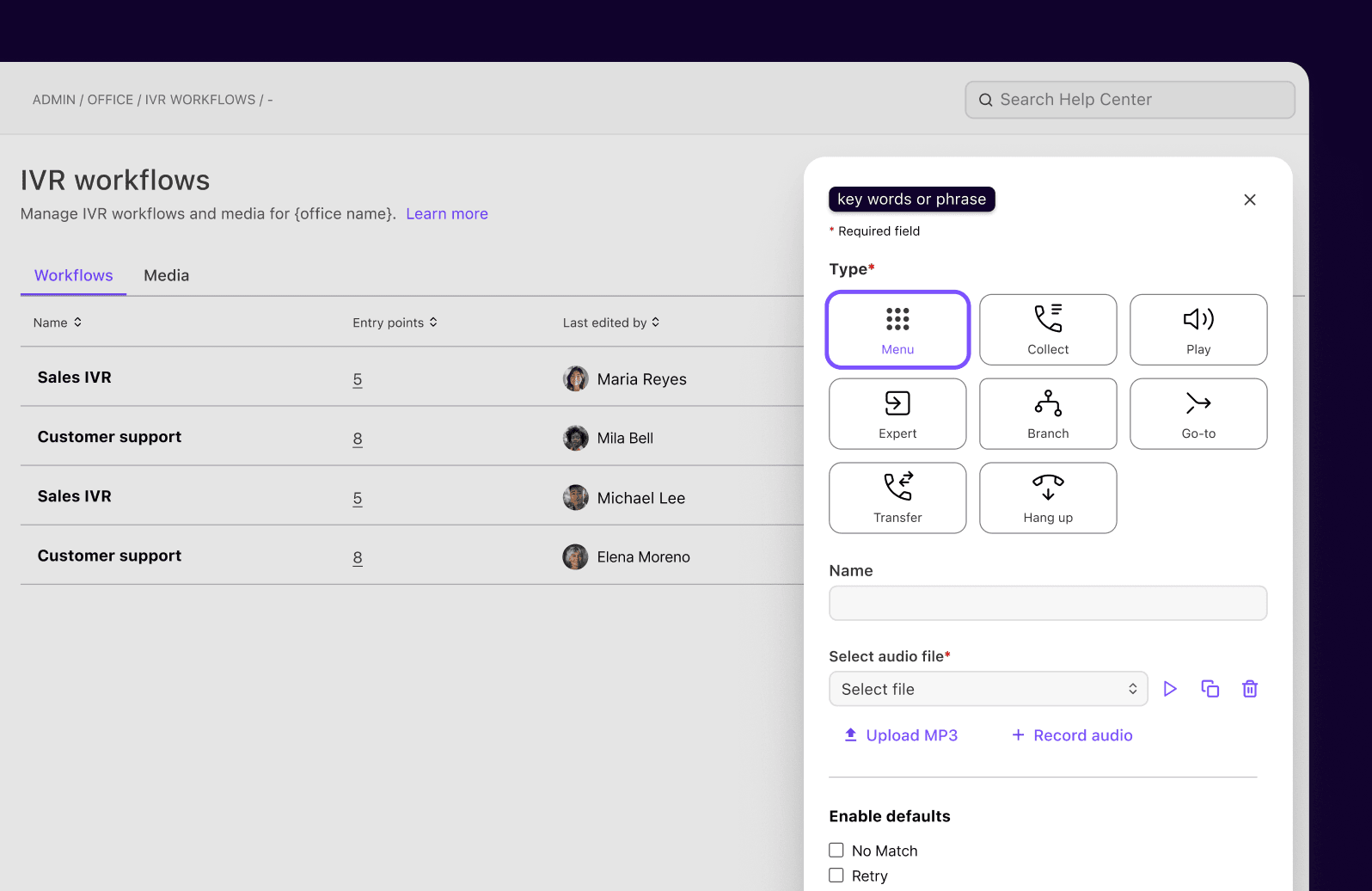
Modern IVR capabilities beyond basic menus
Today's IVR systems bear little resemblance to the frustrating "press 1 for sales" experiences of the past. Modern IVRs incorporate conversational interfaces that allow callers to express their needs in natural language, dynamically personalize experiences based on caller identification, and proactively offer relevant information based on the customer's history and context.
Advanced systems can detect caller frustration through speech analytics and offer immediate assistance or agent transfer. They also provide visual IVR options for smartphone users, allowing customers to navigate menus through touch interactions while maintaining the voice connection.
Voice biometrics and authentication
Market valuations from different research reports indicate a robust and expanding market. In 2024, the global voice biometrics market size was valued at USD 2.30 billion. Another analysis forecasts the voice biometrics segment to grow at an annual rate of 8.3% between 2024 and 2034, reaching a valuation of USD 14,161.4 million in 2024
Voice biometric technology has matured significantly, enabling secure authentication without requiring customers to remember PINs or answer knowledge-based questions. These systems analyze more than 100 physical and behavioral characteristics in a caller's voice to create a unique voiceprint that's extremely difficult to replicate.
Solutions from vendors like Nuance, Pindrop, and NICE offer passive authentication that verifies identity in the background during natural conversation, reducing average handle time by 45-60 seconds per call while significantly enhancing security.
Customer Journey Analytics Tools
Cross-channel tracking capabilities
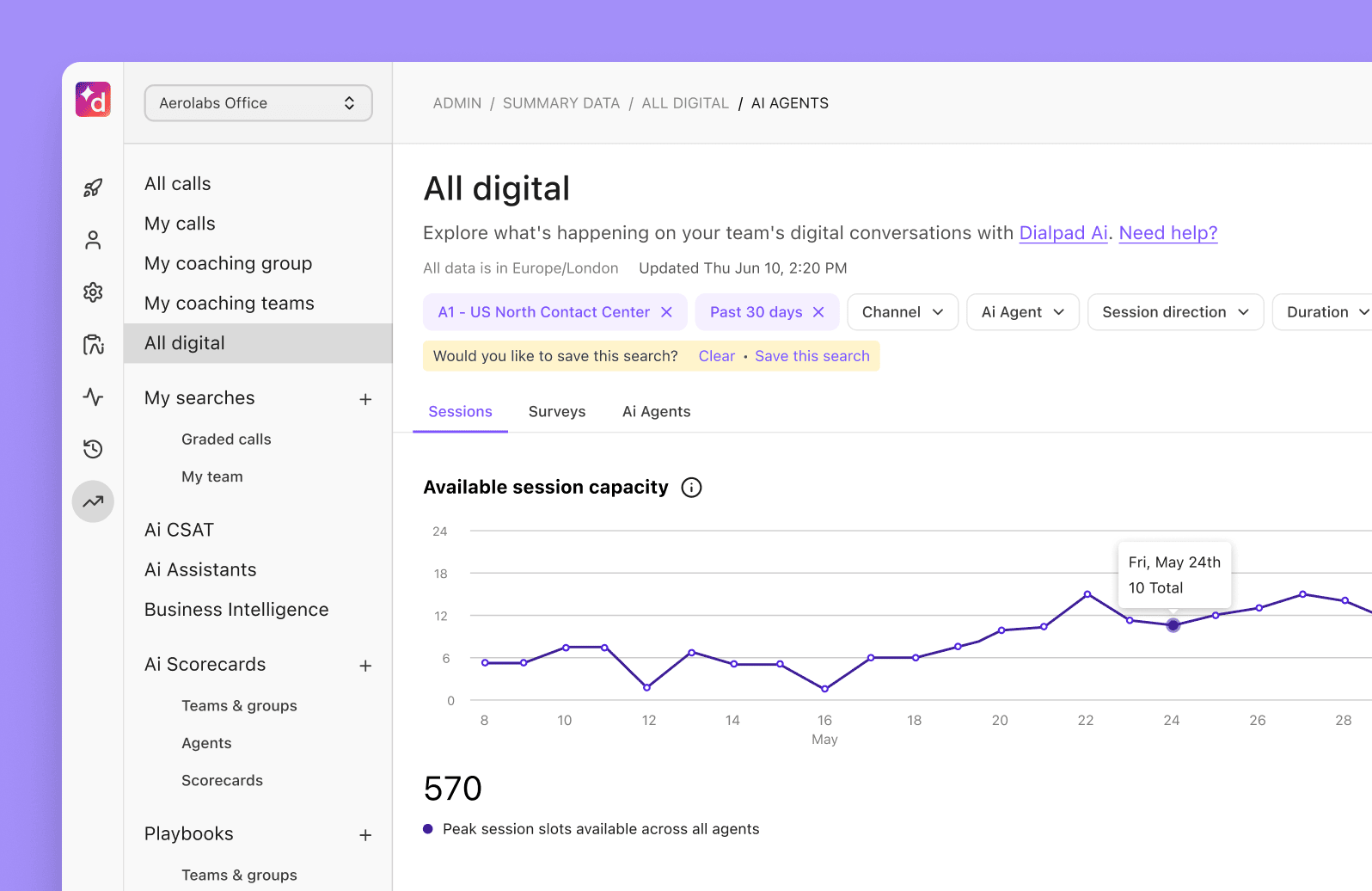
Customer journey analytics tools provide visibility into how customers navigate across channels during their service interactions. These platforms capture every touchpoint—from website visits and mobile app usage to phone calls and chat sessions—creating a comprehensive view of the customer experience.
Leading solutions from companies like Qualtrics, Pointillist, and Verint connect these interactions into coherent journeys, revealing common paths, friction points, and opportunities for automation. For example, analysis might reveal that customers frequently call after attempting to use the website for a specific transaction, indicating an opportunity to improve the digital experience or implement targeted self-service options.
Predictive analytics for identifying customer needs
Advanced analytics platforms leverage machine learning to predict customer behavior and needs based on journey patterns. These tools can identify which customers are likely to require assistance before they actively reach out, enabling proactive service interventions.
Predictive models can determine when customers are at risk of churn, recognize upsell opportunities, and identify the optimal timing for satisfaction surveys. This forward-looking approach transforms contact centers from reactive problem-solvers to proactive value creators.
Using data to optimize automation placement
Journey analytics provide crucial insights into where automation will deliver the greatest impact. By analyzing volume, complexity, and emotional intensity across different interaction types, businesses can prioritize automation investments that deliver the best balance of cost savings and customer experience improvements.
The most successful organizations use these insights to implement "human-in-the-loop" automation strategies, where routine aspects of complex processes are automated while preserving human intervention at emotionally significant moments. This balanced approach typically yields better outcomes than attempts to fully automate entire journeys.
Workforce management automation
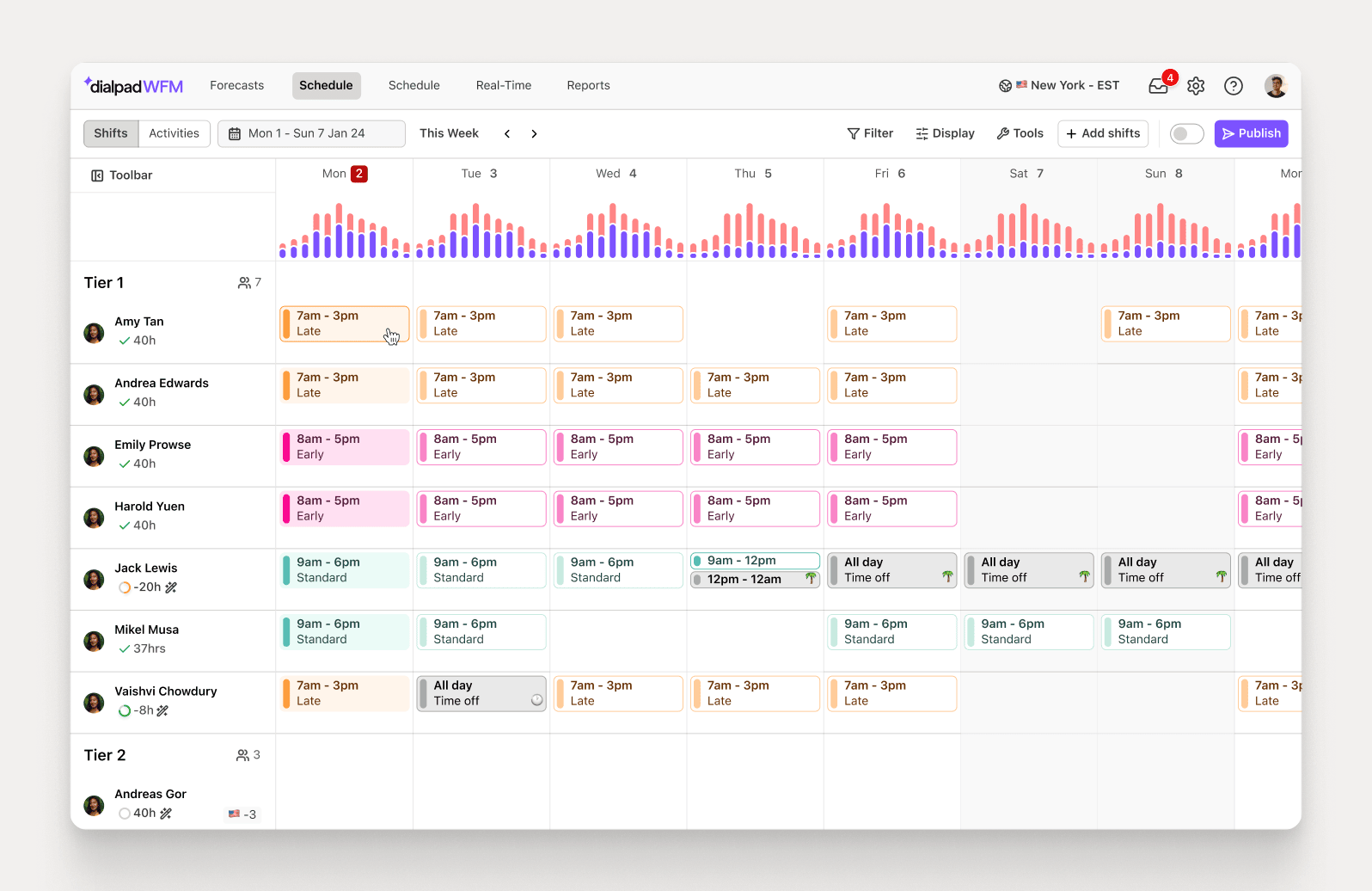
AI-driven staffing and scheduling tools
Workforce management has evolved from static scheduling based on historical call volumes to dynamic systems that continuously optimize staffing based on real-time conditions.
For example, Dialpad delivers Workforce Management capabilities by optimizing support teams and contact centers using tools for workforce scheduling, forecasting, staffing, attendance tracking, and performance management.
Leveraging Dialpad's data, this integration optimizes contact center efficiency and agent productivity. It enhances efficiency and productivity by intelligently scheduling agents, ensuring optimal availability and minimizing idle time.
Some systems incorporate machine learning to identify individual agent productivity patterns and create personalized schedules that align with each team member's peak performance periods.
Automated quality assurance and compliance
Modern contact centers no longer rely solely on manual review of small interaction samples. Automated quality management systems analyze 100% of customer interactions across all channels, using speech and text analytics to evaluate compliance, script adherence, and customer sentiment.
These systems automatically flag interactions for review based on predefined risk indicators, ensuring that quality teams focus their attention on the conversations that matter most. By expanding coverage while reducing manual effort, these tools significantly enhance risk management while providing agents with more consistent and objective feedback.
Agent performance analytics
Performance analytics tools provide comprehensive visibility into agent effectiveness across multiple dimensions, including call center quality assurance. Beyond traditional metrics like average handle time and first-call resolution, these platforms analyze conversation content, customer sentiment, and process adherence to create holistic performance profiles.
Leading solutions incorporate AI-powered coaching systems like AI Live Coach Cards that automatically identify skill gaps and deliver personalized microlearning content to address specific development needs. These targeted interventions improve performance more efficiently than generic training programs, accelerating agent proficiency while reducing attrition.
Sentiment analysis
Real-time emotion detection
Real-time sentiment analysis tools monitor customer interactions as they happen, detecting emotional signals in tone, word choice, and speaking patterns. These systems alert supervisors when conversations become tense, enabling timely intervention before situations escalate.
In telephony and contact center systems, call whisper is a valuable tool that allows supervisors and managers to intervene and support agents with guidance or information while a call with a customer is ongoing.

Beyond crisis prevention, emotion detection helps businesses understand the emotional journey customers experience during service interactions. This insight enables precise optimization of automated systems to address emotional needs—for example, by modifying chatbot responses based on detected frustration or offering to transfer to a human agent when sentiment deteriorates.
Automated quality monitoring
How does sentiment analysis work? Sentiment analysis serves as a powerful complement to traditional quality monitoring approaches. By automatically scoring every interaction based on emotional outcomes rather than just process compliance, businesses gain insight into which policies, procedures, and agent behaviors create positive emotional responses.
Leading platforms correlate sentiment scores with business outcomes like customer retention and share of wallet, helping organizations quantify the financial impact of emotional experiences. This data-driven approach helps elevate customer emotion from a soft metric to a strategic business consideration.
Voice analytics
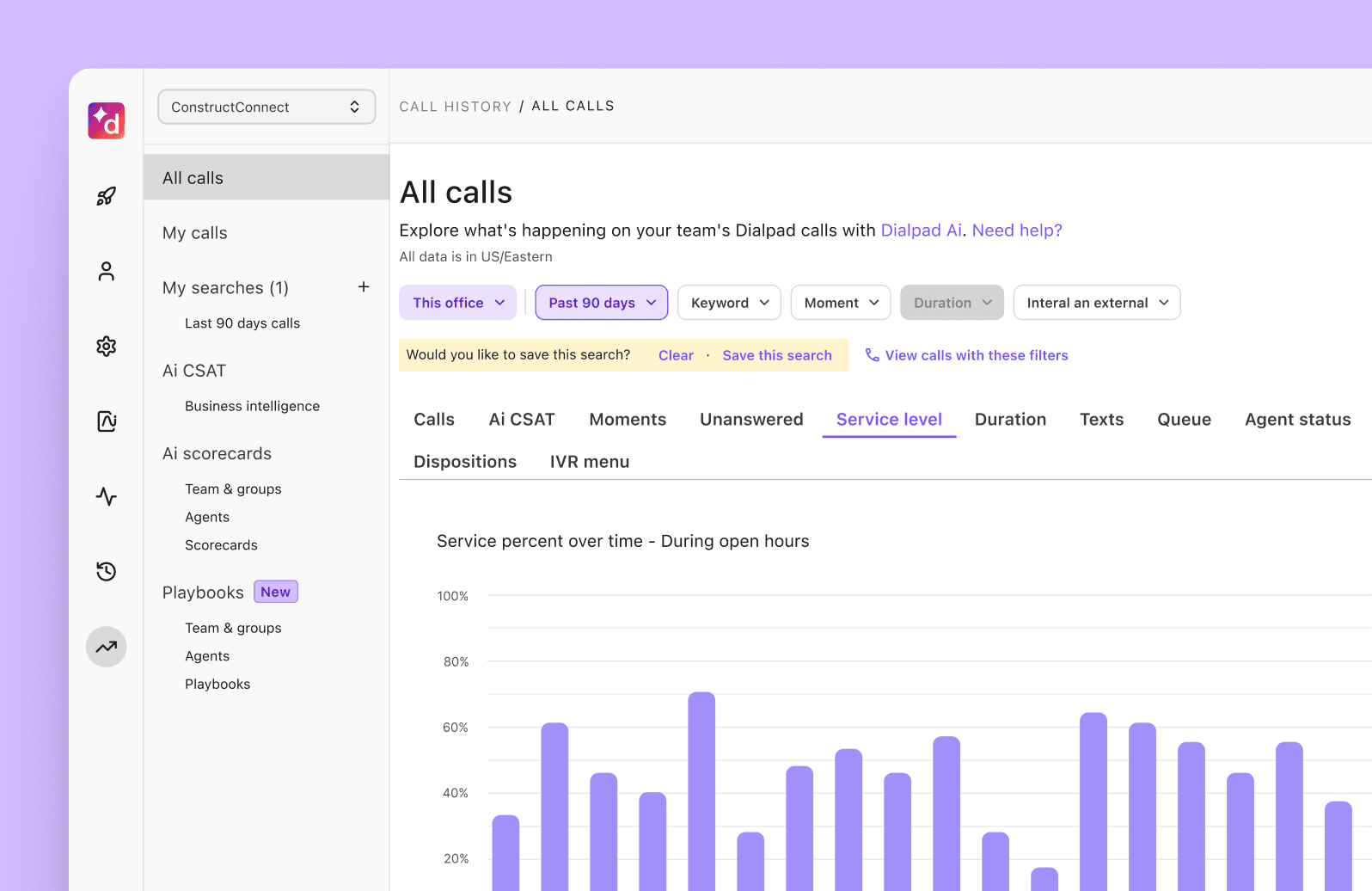
Compliance and script adherence verification
Voice analytics technology has transformed compliance management in regulated industries. These systems automatically verify that agents deliver required disclosures, follow approved scripts, and avoid prohibited language or practices.
Beyond regulatory requirements, real-time voice analytics verifies adherence to service standards and brand guidelines. Systems can detect whether agents are using recommended language, following problem-solving frameworks, and delivering the company's desired customer experience. This consistency is particularly valuable for organizations with large or distributed contact center operations.
Implementation considerations and best practices
How to select the right automation tools
Successful automation begins with clear strategic objectives aligned with specific business outcomes. Rather than pursuing automation for its own sake, organizations should identify their most pressing challenges—whether call volume reduction, improved first-contact resolution, or enhanced compliance—and select tools specifically designed to address these priorities.
Effective evaluation should consider factors beyond feature lists, including:
Integration capabilities with existing systems
Scalability to support future growth
Improvement of customer communications
Total cost of ownership, including implementation and ongoing maintenance
Vendor stability and roadmap alignment with organizational needs
Implementation support and professional services availability
Georgi Petrov, CMO, Entrepreneur, and Content Creator at AIG MARKETER, explains how AI has revolutionized customer communication:
"AI has completely changed how we handle customer communications... We use AI-driven chatbots and automated email sequences to ensure fast, consistent responses while still maintaining a personalized touch."
Petrov notes that their decision to adopt AI was rooted in the need for efficiency and scalability as their customer base expanded, allowing them to manage inquiries 24/7 and free up human support for more complex issues. He emphasizes that the challenge lay in "balancing automation with real, human interaction," which they resolved by using AI for initial engagement before seamless handoffs to live agents.
Crucially, Petrov highlights a vital consideration for any business implementing AI in customer service:
"Security was also a key factor, so we prioritized AI solutions that offer end-to-end encryption and compliance with privacy regulations."

This strategic choice led to a 30% decrease in response times and improved customer satisfaction, proving that "AI is powerful, but the key is using it strategically-enhancing communication without making it feel robotic."
Organizations should also consider whether to pursue a suite approach with comprehensive platforms from a single vendor or a best-of-breed strategy that combines specialized tools from multiple providers. Each approach offers distinct advantages in terms of integration simplicity, functionality depth, and vendor management complexity.
Change management strategies
Technology implementation represents only half the automation challenge. Successful transformation also requires thoughtful change management to address the human factors that often determine project outcomes. Effective strategies include:
Early involvement of frontline agents and supervisors in tool selection and configuration
Clear communication about how automation will enhance rather than replace human roles
Comprehensive training that explains not just how to use new tools but why they're being implemented
Recognition and reward programs that incentivize automation adoption
Phased implementation approaches that build confidence through early wins
According to Prosci's "Best Practices in Change Management" report (2023), organizations that excel at change management typically achieve full adoption 40% faster than those focusing exclusively on technical implementation, resulting in faster ROI realization and higher project success rates.
Measuring ROI on automation investments
Effective measurement begins with establishing clear baselines before implementation and defining specific success metrics aligned with business objectives. While cost reduction often drives initial investment, comprehensive ROI analysis should include both quantitative and qualitative factors:
Quantitative metrics:
Average handle time reduction
Increase in first-contact resolution rates
Reduction in cost per contact
Improvement in agent productivity
Decrease in training time for new agents
Qualitative factors:
Customer satisfaction and loyalty improvements
Enhanced compliance and risk management
Increased agent satisfaction and retention
Improved organizational agility and market responsiveness
Leading organizations establish formal measurement frameworks that track these metrics over time, creating accountability for results and informing future investment decisions.
Future trends in contact center automation
Emerging technologies to watch
Several emerging technologies promise to further transform contact center automation in the coming years:
Augmented reality assistance will enable visual customer support for complex products, allowing agents or automated systems to see what customers see and provide visual guidance overlaid on physical objects.
Emotion AI will advance beyond sentiment analysis to recognize subtle emotional states and adapt service approaches accordingly, potentially predicting customer needs before they're explicitly stated.
Ambient computing interfaces will enable natural conversation with automated systems without requiring specific activation phrases or formal interaction patterns, making automation more accessible to all customer segments.
Hyperautomation approaches combining RPA, AI, and process mining will extend automation beyond customer interactions to transform back-office processes that impact service delivery.
The evolving role of human agents
As automation capabilities advance, the human agent role will continue evolving from transaction processor to complex problem solver and relationship builder. Future agents will require higher emotional intelligence, deeper product expertise, and greater technological fluency to complement automated systems effectively.
Contact centers will increasingly adopt tiered staffing models with specialized roles for different interaction types. Some agents will focus on high-complexity technical issues, others on high-emotion customer retention scenarios, and others on sales and relationship development opportunities identified by AI systems.

How to prepare for next-generation automation
Organizations can position themselves for future success by taking several proactive steps:
Invest in data foundation by implementing comprehensive customer data platforms and interaction analytics that will provide the fuel for future AI applications.
Develop AI governance frameworks that balance innovation with appropriate oversight, addressing ethical considerations like transparency, bias prevention, and human oversight of automated decisions.
Foster an experimentation culture through formal innovation programs that encourage controlled testing of emerging technologies in limited production environments.
Build internal expertise through strategic hiring and development programs focused on critical skills like data science, user experience design, and AI implementation.
Pursue strategic vendor partnerships with technology providers whose roadmaps align with organizational priorities and who demonstrate commitment to ethical AI development and deployment.
Organizations that adopt these steps and leverage today's automation tools can forge contact centers capable of providing outstanding customer experiences and readily adapting to future customer demands and technological progress.
The key to future contact center automation is creating a balanced ecosystem where technology and human agents work in concert, building strong customer relationships and a sustainable competitive advantage.
